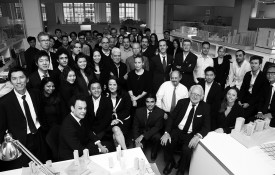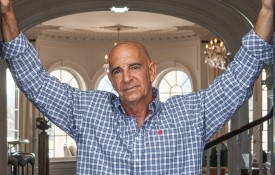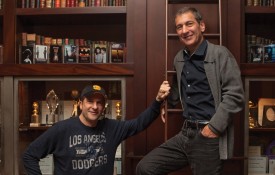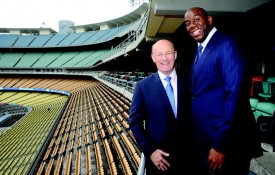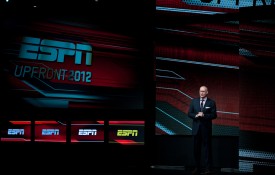Mary Harvey has a vivid recollection of the explosive arrival of women’s soccer into the North American consciousness. The year was 1996 and the U.S. team had just won gold in the inaugural women’s soccer tournament at the Summer Olympic Games in Atlanta.
While it’s true that the Women’s National Team previously had captured the inaugural FIFA Women’s World Cup in 1991, that tournament took place in Guangzhou, China, and most of the U.S. population did not learn of that feat until after it happened. Besides, women’s professional and amateur athletics were still taking a backseat to men’s sports, despite the passage of Title IX, which prohibits sex discrimination in any school or public institution that receives federal funds, nearly a quarter-century earlier.
So when more than 86,000 fans jubilantly celebrated the U.S. team’s Olympic feat in person in 1996, the entire country had finally caught up with the world in terms of the sport’s standing—as well as the competitive legitimacy of the women’s game. Harvey had a prime vantage point for each historic victory, as a member of both the 1991 and 1996 U.S. teams.
Since then, the Northern California native’s trajectory to professional success has not followed the traditional route of a former star athlete finding new purpose after their playing days were over. Quite the contrary: Harvey wasn’t merely moonlighting on the pitch while climbing the corporate ladder. Her athletic double life existed under the radar until her heroics during a televised match outed her to her colleagues at the consulting firm where she was employed.
Not bad for a kid from Los Altos Hills, Calif., who didn’t start playing soccer until she was 12, an “old-timer” by modern standards, when 4 or 5 is the typical age for taking up the sport.
Today, as chief executive of the Centre for Sport and Human Rights, Harvey is striving to ensure that human rights are respected in sports and its events worldwide. The organization’s strategic plan, Convergence 2025, is focused on aligning the sports sector with international human rights standards. Harvey was also part of the team that successful bid to bring the 2026 FIFA World Cup to North America, seeking to help leverage the sport’s ever-growing popularity here.
CSQ caught up with the 58-year-old exec for a wide-ranging conversation about her career path and professional priorities. The prevailing theme? Validation through passion: When you’re doing something you love, the details have a way of working themselves out.
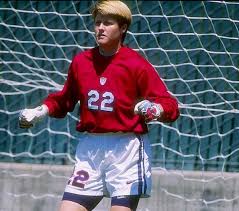
Harvey during her soccer career
CSQ: What has been key to your successful transition from working athlete to full-time professional?
Mary Harvey: I think part of it is the comfort that I felt working around really talented people—people who are perhaps more talented than I. But I had a comfort level in that and I think that served me really well as I continued to advance in “life after sport.” … I had the opportunity to pursue the soccer part of my life all the way through to the ’96 Olympic Games. Being a part of that team of incredible women and incredible leaders, a lot of how I self-describe on leadership [is related to] things that assimilated while I was in the locker room of the U.S. women’s team for eight years. I didn’t really understand what I’d been given in terms of being able to motivate people until I left the bubble and was at business school and working, and I started to get selected for projects that involve working with senior people. And I just had terrific opportunities come my way.
CSQ: What were some “locker-room lessons” that translated smoothly into the business world?
MH: I discovered that what I did for a living had to matter to somebody more than just me. People are looking for inspiration and it’s hard to find. Who makes you want to run through a wall? I had such incredible examples of team captains who provided that on a daily basis. And if you have that in your life, and then you leave it, you miss it. For me, I think I found my voice.
I got started on this whole journey because I loved playing soccer. I also had a bit of wanderlust on learning things from new cultures, new languages—all that always fascinated me.
CSQ: What was your path from the schoolyard to the stadium? Given the construct of professional women’s sports back then, how did you progress into the available opportunities?
MH: Midway through high school, I went from being sort of an average player to a college prospect. And even though I was a late bloomer, I ended up going to the University of California, Berkeley and playing there for four years on their [Division I] team. The program and the university were a great fit for me.
This is where the unexpected part of my life comes in. I graduate, and my dad says, “The soccer stuff is fun and all that, but you have your business degree from Haas [School of Business], what are you going to do with it?”
The national team had just formed [in 1986]; I graduated in ’87. Unless you got picked up by the national team, there really weren’t a lot of opportunities to play. So I went to work for Andersen Consulting, now called Accenture. I joined the San Francisco office, and they were looking for volunteers to work on a long-term project in Germany for four years. I have German ancestry, even though I didn’t speak a lick of German.
And I thought, “Well, I’m starting this new chapter of my life, maybe it’s good for a change,” because I was giving up something I really loved, which was playing soccer. So I was on a one-way ticket to Germany in late 1988. And if you’re trying to give up a soccer habit, I don’t recommend moving there.
CSQ: What was your day-to-day life like once you started to get settled?
MH: They were working us pretty hard, because that’s what you do at Accenture. I missed playing, and it was everywhere around me. The newspapers, the news, the culture. So I joined a local team that just happened to be really good. It was called FSV Frankfurt. And when the women’s Bundesliga [German professional league] kicked off in 1990. It would be one of the teams. … It was an elite sport for sure, but I wasn’t earning a living doing it. I was earning a living working for Accenture.
CSQ: Accenture during the day and Bundesliga at night.
MH: And actually, I didn’t say a whole lot about it at work because, at that time, there were two very different worlds, and the whole integration of female athletes into sort of the C-suite, a world of professional careers, they were two separate worlds back then.
I was using my degree during the day, working with financial services people, building a stock options and futures exchange for German banks … and getting an intensive course in how to speak locker-room German at night.
I remember … at the German Cup final, which is played in Berlin at the Olympic Stadium every year, my team was in the final, and I blew my cover because I saved a penalty … two minutes before the end of the game, and it was on national television. That resulted in some questions on Monday at work.
CSQ: Did the unintended visibility have any impact on your career path?
MH: Playing in Germany led to … a call from [U.S. National Team coach] Anson Dorrance, inviting me to the training camp. So I flew back to the States from Germany. I took vacation and tried out for the U.S. women’s team and made it. If Accenture had said, “Listen, you have to pick, [sport or career],” I would have been in a tough spot. They let me bend the rules as much as possible; they were incredibly supportive. I went on a six-month leave of absence to train and play in the ’91 World Cup, and they let me do it.
Think about 1991. The U.S. women haven’t done anything. … There’s no [Women’s] World Cup. There’s no Olympic Games. … There’s no [media] coverage … and people didn’t really know about the team. And we went to China and won the whole thing.
I came back in 1992 and at that point … there’s all sorts of central banks being set up in different parts of Eastern Europe. And because of my experience in Germany, they wanted to staff me on these projects. I had to make a decision: Do I continue with a national team and go as far as I can before I go back to work, or do I quit now? Because they were going to send me to Prague. And at the time, what is now the Czech Republic didn’t have a lot to offer in terms of women’s football at a high level. That’s when I decided I was going to make a choice and take a career path that enabled a training and playing environment that kept me competitive for the national team.
CSQ: How did you manage that transition? Were there any relationships that proved pivotal to your next chapter?
MH: It was always going to be a situation of finding my own sort of anchor employment-wise, and then navigating from there on the sports side. One of the women that I’d gotten to know during the World Cup was Pia Sundhage. I asked her, “If I can make this employment opportunity … work with this financial services startup in Stockholm, would it work for me to come up there and play [for Sundhage’s team, Hammarby]?” And that’s what ended up happening
I joined a company called Front Capital Systems, which got bought by Sungard. And it required me to work with a German bank and speak German. So I sort of made an opportunity for myself to then move to Stockholm and play and negotiate at the same time. When the national team had a call-up, I was able to leave work and go do that.
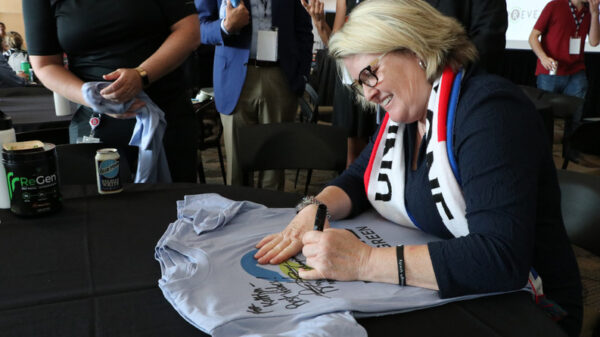
Harvey during the 2015 Pac-12 Centennial Celebration
SOCCER’S BIG-KICK ENERGY ARRIVES
As the 1990s progressed, America’s passion for soccer was growing in lockstep with the U.S. women’s team’s lengthening list of accomplishments. Harvey was poised to contribute to the national cause. In preparation for the 1995 World Cup, U.S. soccer asked the entire women’s team to move to Florida for a residency training program. The commitment would extend into the 1996 Olympic Games. So Harvey moved to Florida with Mia Hamm, Michelle Akers, Brandi Chastain, everybody living and training together.
Thus began an American renaissance of interest in soccer that culminated with the U.S. women’s historic Olympic win in 1996, providing the definitive “big-kick energy” that paved the way for the Bend It Like Beckham generation and beyond.
“The 1996 Olympics is when it started to change,” says Harvey. “We’d never played in front of crowds of 40,000 in the United States. And the night that we won, 86,481 people were there. And FIFA was there, and they saw for the first time that you could actually bring the sport, women’s football, into big stadiums in the United States and it would work.”
After their Olympic Games triumph, the U.S. women’s team started to enjoy the rewards of elevated recognition. Hamm became the sport’s ad hoc ambassador when Nike signed her to a huge marketing campaign. Harvey, who was battling injuries and now filled a backup role, decided to retire, ending an eight-year career. She was also finishing her MBA at UCLA’s Anderson School of Management and was ready to pursue a new chapter in her professional life.
Harvey landed a job at Deloitte, where she joined the strategy practice, working out of Boston. The experience opened the door for a position at FIFA in 2003. “I got picked up in the search to fill out the new CEO’s team,” says Harvey. She was headed back to Europe. At the time, she was the only female member of senior management at FIFA who had actually played the sport.
“My five years at FIFA were transformational for me because there were incredible possibilities to have significant impact on opportunities available to different groups,” Harvey recalls. “For example, with a little bit of investment, you could make [female referees] significantly better versus on the men’s side where it’s more developed.”
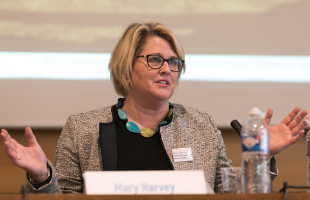
Harvey has been Chief Executive for the Centre for Sports & Human Rights since 2019
HUMAN RIGHTS ON THE WORLD STAGE
In 2017, Harvey joined the bid team for the 2026 FIFA World Cup.
“I wanted to be on the bid team because bringing the World Cup to North America is a once-in-a-generation opportunity,” says Harvey. “I’m old enough to remember what it was like when ’94 happened, and it’s an inflection point. When I showed up there to work on the bid team, they said, ‘We know that you have this background [in sustainability, environmental protection, and sports], but we really need someone to focus on the human rights side.’”
Human rights had never previously been a part of the bidding criteria for something like the World Cup. “It’s all new, nobody knows it, and we need someone to own it,” Harvey explained. “And the leadership of the bid supported it and enabled us to develop the first comprehensive human rights strategy for a mega-sporting event. So when we were awarded the right to host the 2026 FIFA World Cup at the FIFA Congress in Moscow in 2018, that human rights strategy was part of it.”
While Harvey was working on the 2026 bid, off in Europe the nucleus for what would become the Centre for Sport and Human Rights was being formed. Led by Mary Robinson, former president of Ireland and former UN high commissioner for human rights, along with dozens of key stakeholders from the UN, unions, governments, global sponsors, and civil society, the Centre for Sport and Human Rights was officially launched in June 2018 in Geneva.
“The centre is committed to building on the approach that brought it to life—a focus on advancing international human rights and labor standards in sport through engaging all actors in meaningful commitments and cooperation. The centre was established to engage and support the efforts of those who work to run, stage, regulate, develop, sponsor, broadcast, attend, and compete in sport and sporting events. We look to contribute to preventing and addressing harms to people impacted or potentially affected by sport and its events.”
She also notes that every country has its own human rights challenges, “but the Centre was born out of this ideal that sport, to truly live up to its promise, has to be built on a foundation of respect for human rights. So the centre is a human rights organization for the world of sport.”
Team leader, team builder, and consummate team player, Harvey continues to apply lessons learned on the pitch to promoting human rights in organized sports. Turns out, her cheerleading skills are top-notch as well.
“I’ve joked with my team and said, ‘This is the best team I’ve ever had, and I went to the Olympics!’ and they laugh about that,” she says, before changing her tone. “I feel it’s our duty to help sport be all that it can be and deliver on its promise. … It can only do that if there isn’t harm happening. If there’s harm happening, it compromises the value proposition of sport.”









































